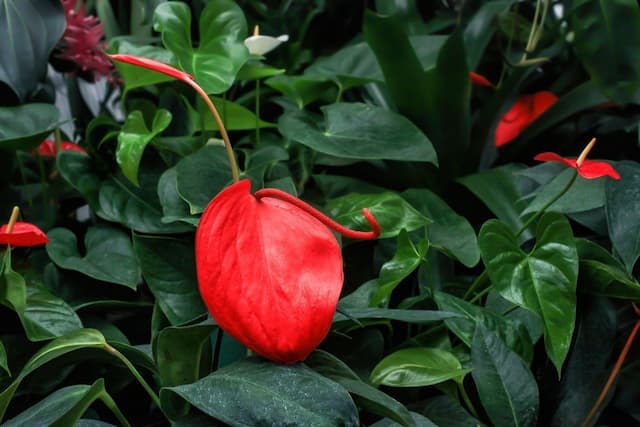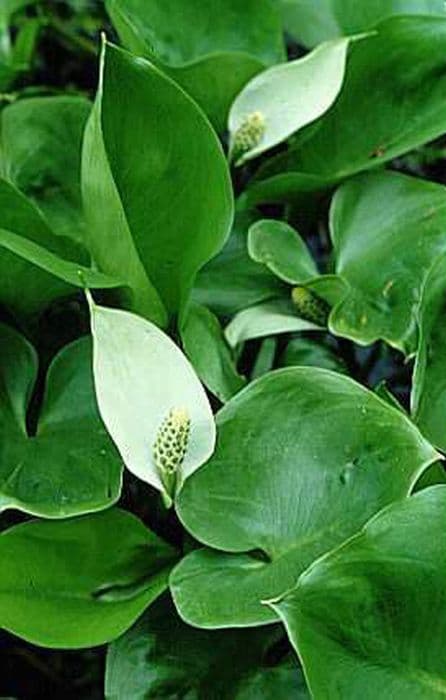Calla Lily 'New York' Zantedeschia 'New York' (PBR)

ABOUT
Zantedeschia 'New York' is commonly known as a Calla Lily. This plant is iconic for its beautifully shaped spathes, which are often mistaken for flowers. These spathes are deep purple-black, almost velvet in appearance, wrapping around a central spike-like spadix that contrasts strikingly in color. This rich hue gives the plant an air of sophistication and elegance. The foliage of the New York Calla Lily is also attractive, featuring large, lush green leaves. These leaves are arrowhead-shaped, with a glossy texture and occasionally display faint white spots. The contrast of the dark blooms against the bright green leaves adds to the plant's allure, making it a popular choice for ornamental purposes. As a cultivated variety, the Zantedeschia 'New York' bears all the classic beauty of Calla Lilies, with a lush and exotic look that captures the eye. The dramatic coloring and graceful form of its blooms make it a favorite for cut flower arrangements and a striking addition to any garden display.
About this plant
 Names
NamesFamily
Araceae
Synonyms
Calla Lily, Arum Lily
Common names
Zantedeschia 'New York' (PBR)
 Toxicity
ToxicityTo humans
The Zantedeschia 'New York', commonly known as the Calla Lily, contains calcium oxalate crystals which are toxic to humans. Ingesting any part of the plant can lead to symptoms such as burning and swelling of the lips, mouth, tongue, and throat. It can also cause difficulty swallowing, nausea, vomiting, and diarrhea. In severe cases, respiratory problems may occur if the airway becomes affected by the swelling.
To pets
The Calla Lily is toxic to pets due to the presence of calcium oxalate crystals. If a pet ingests any part of the plant, they may exhibit symptoms including oral irritation, pawing at the face, drooling, vomiting, and difficulty swallowing. In severe cases, if the swelling is significant, it may lead to difficulty breathing and could potentially obstruct the airway.
 Characteristics
CharacteristicsLife cycle
Perennials
Foliage type
Deciduous
Color of leaves
Green
Flower color
White
Height
1-2 feet (30-60 cm)
Spread
1-2 feet (30-60 cm)
Plant type
Herb
Hardiness zones
8
Native area
Africa
Benefits
 General Benefits
General Benefits- Attractive Flowers: Calla Lily 'New York' produces elegant, trumpet-shaped flowers that add a sophisticated touch to gardens and floral arrangements.
- Easy to Grow: This plant is relatively easy to care for, requiring minimal maintenance once established.
- Long Blooming Period: It offers a longer blooming season than many other plants, providing color and interest throughout the summer.
- Versatile: Suitable for flower beds, borders, containers, and as a cut flower for indoor enjoyment.
- Drought Tolerant: Once established, the Calla Lily 'New York' can tolerate periods of dryness, making it suitable for xeriscaping.
- Compact Size: With its relatively compact growth habit, this variety can fit into smaller garden spaces or pots.
- Deer Resistant: Often resistant to deer, reducing the likelihood of damage from wildlife in the garden.
 Medical Properties
Medical PropertiesThis plant is not used for medical purposes.
 Air-purifying Qualities
Air-purifying QualitiesThis plant is not specifically known for air purifying qualities.
 Other Uses
Other Uses- Zantedeschia 'New York', also known as Calla Lily, can be used as a natural dye source for fabrics. Its deep-colored sap gives a unique tint to textiles.
- The sturdy stems of Calla Lily can be used in the construction of small handcrafted items such as decorative baskets or eco-friendly pens.
- Calla Lily petals can be incorporated into homemade paper to add a unique texture and floral design to the finished product.
- When dried properly, the stalks of the Calla Lily can be used as organic kindling for starting fires due to their quick ignition properties.
- The pliable leaves of the Calla Lily can be creatively used as natural wrapping for small gifts or bouquets, adding a touch of elegance.
- Its bold and striking flowers can be used in photographic compositions and as subjects in botanical illustration workshops.
- Calla Lily spathes can serve as a natural funnel in outdoor settings for transferring liquids between containers.
- The leaves of the Calla Lily can be utilized as impromptu bookmarks that add a botanical flair to your reading experience.
- Due to their distinctive shape, Calla Lilies can be used as stencils for crafting and painting projects.
- The sap, while needing careful handling, can be used in traditional ceremonies as a symbol of purification and sanctification in some cultures.
Interesting Facts
 Feng Shui
Feng ShuiThe Calla Lily is not used in Feng Shui practice.
 Zodiac Sign Compitability
Zodiac Sign CompitabilityThe Calla Lily is not used in astrology practice.
 Plant Symbolism
Plant Symbolism- Purity and Innocence: The Zantedeschia 'New York', more commonly known as the Calla Lily, often symbolizes purity and innocence due to its sleek, trumpet-shaped flowers and crisp, clean appearance.
- Beauty: Calla Lilies are regarded as symbols of beauty, with their elegant form and graceful presence often used in art and design.
- Rebirth and Resurrection: The Calla Lily's association with Easter and springtime ties it symbolically to themes of rebirth and resurrection, representing new beginnings and fresh starts.
- Marriage and Devotion: Due to their stately and refined looks, Calla Lilies are often used in weddings, symbolizing marital bliss and devotion between partners.
- Transcendent Love: The Calla Lily can symbolize a love that transcends the physical realm, suggesting a deep spiritual connection or eternal love that endures beyond death.
- Overcoming Challenges: Because Calla Lilies bloom in a range of environments, they can represent the ability to overcome challenges and flourish in adversity.
 Water
WaterThe Calla Lily 'New York' should be watered thoroughly and allowed to drain each time, as they prefer evenly moist soil. They typically need watering once a week but this can vary depending on the humidity and temperature of the environment. Make sure to provide about one gallon of water per plant which will suffice for a week unless the soil dries out faster due to higher temperatures or less humidity. It's crucial not to overwater, as standing water can lead to root rot. During their dormancy in winter, reduce watering significantly.
 Light
LightCalla Lily 'New York' thrives in bright, indirect light but can also tolerate part sun. The best spot for these plants is a location where they get morning sunlight but are shielded from the intense sun in the afternoon. A north or east-facing window would be ideal for indoor plants, ensuring they get enough light without the harsh direct afternoon sun.
 Temperature
TemperatureThe Calla Lily 'New York' enjoys temperatures between 60 and 75 degrees Fahrenheit to flourish. They can survive momentary dips down to about 50 degrees Fahrenheit, but consistently cold temperatures or frost can damage the plant. It is important not to expose the plant to temperatures above 80 degrees Fahrenheit for extended periods, as it can cause stress.
 Pruning
PruningCalla Lily 'New York' benefits from pruning to remove spent flowers and yellowing leaves, which encourages healthy growth and more blooms. It's best to prune when you notice these signs of fading vitality, typically after flowering. Cut the stems as close to the base as possible without damaging the main plant. The ideal time for heavier pruning is late fall or early winter when the plant enters dormancy.
 Cleaning
CleaningAs needed
 Soil
SoilCalla Lily 'New York' thrives in a well-draining, rich, potting mix with a pH of around 5.5 to 6.5. A mixture of peat, perlite, and loamy soil is recommended to maintain the right balance of drainage and nutrient retention. Regular monitoring and maintenance of pH within this range will support healthy growth.
 Repotting
RepottingCalla Lily 'New York' should be repotted every two years to replenish the soil and provide room for growth. Repotting is best done in the spring when the plant is emerging from dormancy, before it enters its active growth phase.
 Humidity & Misting
Humidity & MistingCalla Lily 'New York' prefers a moderate humidity level of about 40-60%. Consistently high humidity can support its lush foliage and flower production, but good air circulation is important to prevent fungal diseases.
 Suitable locations
Suitable locationsIndoor
Provide bright, indirect light and keep moist.
Outdoor
Plant in partial shade and keep soil moist.
Hardiness zone
8-10 USDA
 Life cycle
Life cycleThe Zantedeschia 'New York' (PBR), commonly known as Calla Lily 'New York', begins its life cycle from a rhizome, a type of underground stem. After planting, the rhizome sprouts roots and shoots that emerge from the soil as the plant enters the vegetative stage, characterized by the growth of its iconic arrow-shaped leaves. As it matures, the Calla Lily 'New York' produces its distinctive flowers, which are technically spathes surrounding a central spadix, typically in the late spring to summer. After pollination, which may be facilitated by insects attracted to the spadix, the plant may produce berries containing seeds. Once the flowering and potential seed production are complete, the plant enters a dormancy period, often corresponding with cooler and drier seasons, where it conserves energy. The cycle restarts with the return of optimal growing conditions, prompting the rhizome to once again produce new shoots and leaves.
 Propogation
PropogationPropogation time
Spring-Early Summer
Zantedeschia 'New York', commonly known as the Calla Lily, is typically propagated through division of its rhizomes. The best time to propagate the Calla Lily by dividing its rhizomes is in autumn after the foliage has died back, or in early spring before growth resumes. To propagate through division, the rhizomes should be carefully dug up and the clumps separated by gently pulling apart the rhizomes, ensuring that each division has at least one growth bud. These sections can then be replanted at a depth of around 3 to 4 inches (7.5 to 10 centimeters) in well-draining soil, with the growth point facing upward. Water the newly planted divisions to establish them, and new growth should appear in a few weeks. This form of propagation allows gardeners to produce new plants that are genetically identical to the parent, maintaining all the desirable traits of the 'New York' variety.









